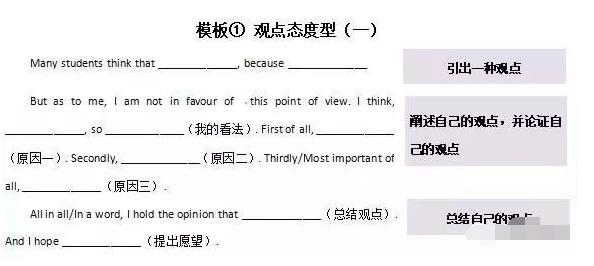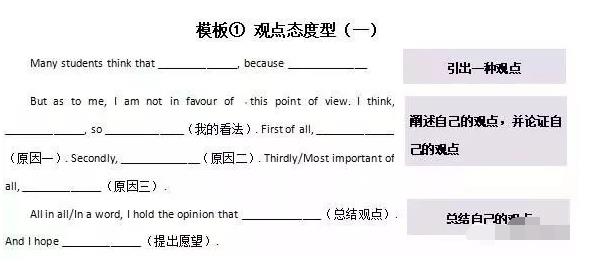英语议论文格式
Posted
tags:
篇首语:本文由小常识网(cha138.com)小编为大家整理,主要介绍了英语议论文格式相关的知识,希望对你有一定的参考价值。
有个exchange student 的项目,要写一篇<My Favourite Film>的议论文,我该怎么着手啊?格式,范例,谢谢哈.^_^
1、议论文的格式:
议论文的格式应由三个部分组成:<1> 立论部分;<2> 论证部分; <3> 结论部分。一般说来,议论文可分三个基本段落来写:
第一段引出话题;
第二段立论且加以论证;
第三段给出明确的结论。第二段是中心段落,应试者应将主要的内容放在第二段中,同时也要注意开篇及结尾段落的完整性,且应尽量做到首尾呼应,切忌前后矛盾。
2、写作攻略
初中生在写议论文时要首先考虑自己的观点是什么,明确观点后要围绕观点进行论证,最后再进行总结。议论文在写作手法上以议论为主,但有时也要运用说明、叙述、描写等手法。初中议论文的写作格式一般为三段式:开头、主体和结尾。一般写作步骤如下:
第一步:确定主题,引出论点;
第二步:通过摆事实、讲道理来支持自己的观点。所用的事实、原因、理由应紧密地同结论联系在一起;
第三步:得出结论。要简明扼要、回扣全文。

拓展资料
1、【模板范文】
Many students think that they do not need to learn Engish, because they don't plan to go abroad.
But as to me, I am not in favour of this point of view. I think that English is very important to us, so we should learn English well. First of all, in the opening times, if you want to do business with foreigners, you must use English because most of them speak and write in English.
Secondly, in the world today most books are written in English. If you know much English, you can read newspapers and magazines in English. Most important of all, you can learn something more widely.
All in all, I hold the opinion that we should learn English well. And I hope that all the students can use English freely.

2、【模板范文】
Nowadays,many students like to make friends online.About this different people have different opinions.
On the one hand,some
people think it's interesting totalk with friends online.So you will never feel lonely when youare alone.If you are lucky enough to make a friend from Englishspeaking country,you can improve your English greatly.Moreover, it's pretty cool to have several foreign friends.
But every coinhas two sides.Firstly,only a few people have made really goodfriends online.Many people are cheated by the "friends".Besides,it is terrible for students to spen
d much time makingfriends and talking online.
Some people say making friends online is making trouble.Ithink there is something in what they say.
参考技术A一,议论文的格式:
议论文的格式应由三个部分组成:
立论部分,
2.论证部分。
3.结论部分。
二,一般说来,议论文可分三个基本段落来写:
1.第一段引出话题,
2.第二段立论且加以论证,
3.第三段给出明确的结论。
第二段是中心段落,应试者应将主要的内容放在第二段中,同时也要注意开篇及结尾段落的完整性,且应尽量做到首尾呼应,切忌前后矛盾。
三,写作攻略:
初中生在写议论文时要首先考虑自己的观点是什么,明确观点后要围绕观点进行论证,最后再进行总结。议论文在写作手法上以议论为主,但有时也要运用说明,叙述,描写等手法。初中议论文的写作格式一般为三段式:开头,主体和结尾。
四,一般写作步骤如下:
1.确定主题,引出论点。
2.通过摆事实,讲道理来支持自己的观点。所用的事实,原因,理由应紧密地同结论联系在一起。
3.得出结论。要简明扼要,回扣全文。

扩展资料:
1.模板范文
Many students think that they do not need to learn Engish, because they don't plan to go abroad。
But as to me, I am not in favour of this point of view。I think that English is very important to us, so we should learn English well。First of all, in the opening times, if you want to do business with foreigners, you must use English because most of them speak and write in English。
Secondly, in the world today most books are written in English。If you know much English, you can read newspapers and magazines in English。Most important of all, you can learn something more widely。
All in all, I hold the opinion that we should learn English well。 And I hope that all the students can use English freely。
参考资料:百度百科——英语作文
1:It is well-known to us that……(我们都知道……)==As far as my knowledge is concerned, …( 就我所知…)
2:Recently the problem of…… has been brought into focus. ==Nowadays there is a growing concern over ……(最近……问题引起了关注)
3:Nowadays(overpopulation)has become a problem we have to face.(现今,人口过剩已成为我们不得不面对的问题)
4:Internet has been playing an increasingly important role in our day-to-day life. It has brought a lot of benefits but has created some serious problems as well.(互联网已在我们的生活扮演着越来越重要的角色,它给我们带来了许多好处但也产生了一些严重的问题)
5:With the rapid development of science and technology,more and more people believe that……(随着科技的迅速发展,越来越多的人认为……)
6:It is a common belief that……==It is commonly believed that……(人们一般认为……)
7:A lot of people seem to think that……(很多人似乎认为……)
8:It is universally acknowledged that + 句子(全世界都知道...)
二、表达不同观点
1:People's views on……vary from person to person. Some hold that……However, others believe that……(人们对……的观点因人而异,有些人认为……然而其他人却认为……)
2:People may have different opinions on……(人们对……可能会持有不同见解)
3:Attitudes towards (drugs)vary from person to person.==Different people hold different attitudes towards(failure)(人们对待吸毒的态度因人而异)
4:There are different opinions among people as to……(对于……人们的观点大不相同)
三、表示结尾
1:In short, it can be said that……(总之,他的意思是……)
2:From what has been mentioned above, we can come to the conclusion that……(从上面提到的,我们可以得出结论……)
3:Taking all these factors into consideration, we naturally/reasonably come to the conclusion that……(把所有的这些因素加以考虑,我们自然可以得出结论……)
4:Hence/Therefore, we'd better come to the conclusion that……(因此,我们最好的出这样的结论……)
5:There is no doubt that (job-hopping)has its drawbacks as well as merits.(毫无疑问,跳槽有优点也有缺点)
6:All in all, we cannot live without……,but at the same time we must try to find out new ways to cope with the problems that would arise.(总之,我们没有……无法生活,但同时我们必须寻求新的解决办法来面对可能出现的新问题)
四、提出建议
1:It is high time that we put an end to the (trend).(该是我们停止这一趋势的时候了)
2:There is no doubt that enough concern must be paid to the problem of……(毫无疑问,对……问题应予以足够重视)
3:Obviously ,if we want to do something … it is essential that……(显然,如果我们想要做么事,很重要的是……)
4:Only in this way can we ……(只有这样,我们才能……)
5:Spare no effort to + V (不遗余力的)
五、预示后果
1:Obviously,if we don't control the problem, the chances are that……will lead us in danger.(很明显,如果我们不能控制这一问题,很有可能我们会陷入危险)
2:No doubt, unless we take effective measures, it is very likely that ……(毫无疑问,除非我们采取有效措施,否则我们很可能会……)
3:It is urgent that immediate measures should be taken to stop the situation(很紧迫的是应立即采取措施阻止这一事态的发展)
六、表示论证
1:From my point of view, it is more reasonable to support the first opinion rather than the second.(在我看来,支持第一种观点比第二种更有道理)
2:I cannot entirely agree with the idea that……(我无法完全同意这一观点)
3:As far as I am concerned/In my opinion,……(就我来说……)
4:I sincerely believe that……==I am greatly convinced (that)子句.(我真诚地相信……)
5:Finally, to speak frankly, there is also a more practical reason why ……(最后,坦率地说,还有另外一个实际的原因……)
七、给出原因
1:The reason why + 句子 ~~~ is that + 句子 (...的原因是...)
2:This phenomenon exists for a number of reasons .First,…….Second,…….Third,……。这一现象存在有很多原因的,第一……第二……第三……
3:For one thing,…… For another thing,…… ==On the one hand,……On the other hand……一方面……另一方面……
4:I quite agree with the statement that……The reasons are chiefly as follows.我十分赞同这一论述,即……。其主要原因如下。
八、列出解决办法和批判错误观点做法
1:The best way to solve the troubles is……解决这些麻烦的最好办法是……
2:As far as something is concerned,……就某事而言,……
3;It is obvious that……很显然……
4:It may be true that……but it doesn't mean that……可能……是对的,但这并不意味着……
5;It is natural to believe that……but we shouldn't ignore that……认为……是自然的,但我们不应忽视……
6:There is no evidence to suggest that……没有证据表明……
九、表示好处和坏处
1:It has the following advantages.它有如下优势
2:It is beneficial/harmful to us.==It is of great benefit/harm to us.它对我们有益处
3:It has more disadvantages than advantage.他有很多不足之处
十、表示重要、方便、可能
1:It is important(necessary/difficult/convenient/possible)for sb to do sth.对于某人做……是……
2:It plays an important role in our life.
十一、采取措施
1:We should take some effective measures.我们应该采取有效措施
2:We should try our best to overcome/conquer the difficulties.我们应该尽最大努力去克服困难
3:We should do our utmost in doing sth.我们应该尽力去做……
4:We should solve the problems that we are confronted/faced with.我们应该解决我们面临的困难
十二、显示变化
1:Some changes have taken place in the past five years.过去五年发生了很多变化
2:Great changes will certainly be produced in the international communications.在国际交流中理所当然会发生很多大的变化
3:It has increased/decreased from…to…他已经从…增加/减少到…
4:The output of July in this factory increased by 15%.这个工厂7月份产量以增加了15%
十三、表明事实现状
1;We cannot ignore the fact that……我们不能忽略这个事实……
2:No one can deny the fact that……没人能否认这个事实……
3:This is a phenomenon that many people are interested in.
4:be closely related to ~~ (与...息息相关)
十四、进行比较
1:Compared with A,B……与A比较,B……
2;I prefer to read rather than watch TV.
十五、常用英语谚语
1:Actions speak louder than words.事实胜于雄辩
2:All is not gold that glitters.发光的未必都是金子
3:All roads lead to Rome.条条大路通罗马
4:A good beginning is half done.良好的开端是成功的一半
5:Every advantage has its disadvantage有利必有弊
6:A miss is as good as a mile.失之毫厘,差之千里
7:Failure is the mother of success.失败是成功之母
8:Industry is the parent of success.勤奋是成功之母
9:It is never too old to learn.活到老,学到老
10:Knowledge is power.知识就是力量
11:Nothing in the world is difficult for one who sets his mind to it.世上无难事,只怕有心人 参考技术C
写作准备:
1、熟悉写作要求。首先建议买本带讲解的真题作文集,浏览范文。熟悉常考话题、惯常写法、用词用句组段的特点。另外,结合官方评分标准,熟悉作文的各个得分档次,为以后自评自改作文做个铺垫。
2、积累写作素材。准备个笔记本,通读细读范文来积累常用词汇及替换词、词伙、句型、语法、话题、观点、案例、甚至写作样本等素材。
除过阅读真题作文集,还注意在平时的阅读和听力训练中收集话题写作相关素材。我个人喜欢的一档电台节目是中国国际广播电台(CRI)的“圆桌会议(Round Table)”,里面有当下非常接地气的话题讨论,比如拼车、快递、青少年犯罪等。
另外,TED演讲里也有非常好的原创观点,话题涉及教育、文化、科技、社会等不同领域。看演讲不但可以开拓视野,锻炼思考能力,有兴趣的话也可以研究其演讲词的写作技巧,对写作能力的提高也大有裨益。
3、打好写作基本功。英文底子不够扎实的同学可以从历年优秀范文中选取若干篇进行翻译-回译、背诵-默写等练习,在语法书、词典、写作老师的帮助下,锻炼遣词造句的能力。
组词造句这一关过了之后,就可以研究写作技巧了。写作技巧包括如何开头、如何展开话题、如何结束作文、如何让文章更有说服力等方面。写作技巧可以参照作文书里的技巧介绍,也可以自己通过分析范文来研究总结。
4、玩中写(可选)。应试作文写作模式比较单一,常常被同学戏谑为“八股文”,练习一段时间一般会产生厌倦感。这时候可以结合自己的兴趣,选择非常喜欢的看图说话类、故事类、时尚类、抒情类好句好文进行仿写、改写、续写、扩写、缩写、口头写等练习;
也可以任意发挥进行自由写、创意写、记日记,这些看似“无用”的练习都可以提升写作兴趣和写作基础。综合使用各种练习方法,可以全面提升写作和口语表达水平。写作水平提高了,口语也无疑会有长足的进步。
写作格式:
1、审题:拿到题目后先读题,标出关键信息。这一步注意弄清题意,知道通过写作要解决什么问题。
2、明确立场:作为当代大学生,需要以国际化的视野,科学、批判性地看待问题和分析问题。因此,注意我们的观点最好符合社会发展的大趋势,同时又能辩证地分析大趋势下的部分逆流并加以诊断性分析。
3、头脑风暴收集素材、并简单分类:这一步把自己的话题观点、案例、相关词汇等列出来,备忘。基于读题信息和收集的素材,形成论点,根据题意选择适当的素材,形成一个两百多字能说清楚的论点。
4、打好框架:一般来讲,250字儿的作文可以分为四至五段。第一段先给出论点,主体段结合审题阶段的观点类素材进行分类,草拟出每段的主题句(可以是短语),即分论点。然后把细节、事实、案例等素材与主题句对应,以便进行解释、举例、或补充。最后一段可以是对论点的情境化深入,也可以是分论点的整体性解析。
5、修改:写完后,用官方评分标准来分析自己的作文,给自己评分。然后与范文对比优缺点,再修订或重写。经得起推敲的好文是一遍遍修改出来的。

扩展资料:
英语议论文的注意事项:要坚持积累和训练,要写就写得整齐。应试中短文写作部分通常叫essay writing,其实只是要求考生表达对某事的立场或观点加之简要的分析和解释而已,因此除非有明确要求,通常不需要写题目。因为在国外所谓有题目的essay要正式的多,通常为上千字到几千字,有些甚至包括文献综述及分析。
如果要求写题目,那也是为了提醒考生在写作过程中时刻保持focus不至于跑题。作文题目一般有名字短语(如My View on Learning with APPs)、问句(如Is Learning with APPs a Good thing?)等形式。
其实质上是对审题阶段所提问题discussion question的陈述或回答,而正文其实就是对问题的分析和解答。 如果正文不能回答题目中蕴含的问题,那就是“文不对题”了。
参考技术D 一、正反观点式议论文万能句(对比观点型)作文框架模版
给出观点——正反观点二选一(有的人认为,有的人认为,你的观点)
There is a widespread concern over the issue that________(作文题目)But it is well known that the opinion concerning this hot topic varies from person to person. (开头一般题目给出)
The majority think that________(观点一). First of all,________(原因一).Furthermore, ________(原因二). So it goes without saying that________(观点一).
People,however,differ in their opinions on this matter.Some people hold the view that________(观点二). On the one hand,________(原因一). On the other hand,________(原因二). Therefore, there is no doubt that ________(观点二)
As far as I am concerned, I firmly support the view that观点一或二.It is not only because ________(原因一), but also because ________.(原因二)It's high time that________. (喊口号) Only in this way eventually can we ________(支持这一观点的结果)
模版译文:
有一个广泛引起关注的问题________。但众所周知有关这个热点话题的观点因人而异。
绝大多数人认为________。首先,________。而且,________。因此不言而喻________。
然而在这个话题上人们的观点各不相同。有的人持有的观点是________。一方面,________。另一方面,________。因此,毫无疑问________。
就我而言,我强烈支持________的观点。不仅因为________,还因为________。该是________的时候了。只有这样我们最终才能________。
二、“A或者B”类议论文万能句:(说明利弊型)
作文框架模版:说明某一事物的优缺点及自己的看法
Nowadays many people prefer A because it has a significant role in our daily life.
Generally speaking, its advantages can be seen as follows. First of all ,________(A的优点之一).Moreover,________(A的优点之二).Besides ,________(A的优点之三)
But every coin has two sides. The negative aspects are also apparent. One of the important disadvantages is that ________(A的第一个缺点).To make matters worse, ________(A的第二个缺点).
Through above analyses, I believe that the positive aspects overweigh the negative ones. Therefore, I would like to________ (我的看法).
或者(From the comparison between these positive and negative effects of A, we should take it reasonably and do it according to the circumstances we are in. Only by this way, (对前景的预测).
模版译文:
现如今很多人更喜欢A,因为它在我们生活中扮演了一个重要的角色。
总的来说。他的优点如下。首先________。而且,________。除此之外,________。
但凡事都有利有弊,消极的一面也是很明显的。最重要的缺点是________。更糟糕的是________
通过以上分析,我认为积极的一面胜过消极的一面。因此,我更喜欢________。
三、观点论述类议论文万能句:(现象说明型)
作文框架模版
现象说明型:说明某一现象及其产生的原因和自己的看法
Nowadays, there are more and more ________ (某种现象) in ________ (某种场合). It is estimated that________ (相关数据). Why have there been so many ________ (某种现象)? Maybe the reasons can be listed as follows. To begin with, ________ (原因一). Besides, (原因二). Last but not least, ________ (原因三).
Personally, the main cause of ________ (某种现象) is due to ________ (最主要原因). It is high time that something were done upon it. For one thing,________ (解决办法一). For another, ________ (解决办法二). All these measures will certainly reduce the amount of ________ (某种现象).
模版译文:
现如今在________(某种场合) 有越来越多的________。(某种现象) 据统计,________。
为神马有如此多的________?也许原因如下。首先,________。除此之外,________。最后但同样重要的是,________。
我认为,引起________的主要原因是________。该是时候采取些措施了。一方面,________。另一方面,________。所有这些措施都将会解决________。
阐述主题型:要求从一句话或一个主题出发,按照提纲的要求进行论述.
四、"How to"类议论文万能句:(问题解决型)
作文框架模版
模版①要求考生列举出解决问题的多种途径 1.问题现状 2.怎样解决(解决方案的优缺点)
In recent days, we have to face a problem________A, which , surprisingly , is becoming more and more serious. First of all, ________(说明A的现状).Secondly, ________(举例进一步说明现状)
Confronted with A, we should take a series of effective measures to cope with the situation. For one thing,________(解决方法一). For another, ________(解决方法二). Finally, ________解决方法三).
Personally, I believe that ________(我的解决方法). Consequently, I’m confident that a bright future is awaiting us because ________(带来的好处).
模版译文:
现如今我们不得不面对一个问题________A,这个问题正变得越来越严重。首先,________。其次,________。
面对A,我们应该采取一系列的措施来解决这个处境。一方面,________。另一方面,________。最后,________。
就我而言,我认为________。因此,我相信一个崭新的未来正在等待着我们,因为________。
图表作文写作万能句(图表分析型)(常给出折线图、饼状图、条形、扇形等统计图)
描写图表变化趋势的词:(建议使用斜体加横线的词,个人认为比较形象)
上升:increase / rise / go up / rocket(迅速增加) 下降:decrease / reduce / come down/ decline
快:quickly / rapidly / sharply / dramatically 慢:slowly / gradually
作文框架模版
As is shown/indicated/illustrated by the figure/percentage in the table (graph/ picture /pie /chart ), ________(作文的议题)has been on rise (increases /drops /decreases ), significantly /dramatically/steadily rising/decreasing from_% in _年_ to _%_ in _年_. From the sharp /marked decline/ rise in the chart, it goes without saying that________(现象总结)
There are at least two good reasons accounting for________(总结的现象). On the one hand, ____. On the other hand, ________ is due to the fact that ________. In addition, __ is responsible for ________. (Maybe there are some other reasons to show ______.But it is generally believed that the above mentioned reasons are commonly convincing. )
As far as I am concerned,I hold the view that _______. It's high time that________. (喊口号) Only in this way can ________(支持这一观点的结果)
模版译文:
正如图表所展示的那样,________一直在增长。从图表中飞速的增长,不言而喻________。
至少有两个原因来解释________。一方面,________。另一方面,________是因为________.除此之外,________是________的原由.
就我而言,我持有________的观点.该是________的时候了.只有这样我们最终才能________。
英语论文参考文献标准格式
参考技术A英语论文参考文献标准格式
在各领域中,说到论文,大家肯定都不陌生吧,通过论文写作可以培养我们独立思考和创新的能力。那么一般论文是怎么写的呢?以下是我帮大家整理的英语论文参考文献标准格式,仅供参考,大家一起来看看吧。

英语论文参考文献标准格式1
用Times New Roman.每一条目顶格,如某一条目超过一行,从第二行起“悬挂缩进”2字符。参考文献中所有标点与符号均在英文状态下输入,标点符号后空一格。
参考文献条目排列顺序:英文文献、中文文献、网络文献。分别按作者姓氏字母顺序排列。文献前不用序号。
1)英文参考文献:
(1)专著与编著
排列顺序为:作者姓、名、专著名、出版地、出版社、出版年。
例如:
Brinkleyork: Knopf, 1993.
专著名中如果还包含其他著作或作品名,后者用斜体。
例如:
Dunn, Richard J ed. Charlotte Bront: Jane EyreNew York: Norton, 1971.
A、两个至三个作者
第一作者的姓在前,名在后,中间用逗号隔开;其余作者名在前,姓在后,中间无逗号;每个作者之间用逗号隔开,最后一个作者的姓名前用“and”,后用句号。
例如:
B、三个以上作者
第一作者姓名(姓在前,名在后,中间加逗号)后接“et al.”,其他作者姓名省略。
例如:
University of Hawaii Press, 1997.
C、同一作者同一年出版的不同文献,参照下例:
Widdowson, Henry G1998a.
Widdowson, Henry G. Cambridge:
Cambridge University Press, 1998b.
(2)论文集
参照下例:
Thompson, Pett. “Modal Verbs in Academic Writing”. In Ben Kettlemann & York: Rodopi, 2002: 305-323.
(3)百科全书等参考文献
参照下例:
Fagan, Jeffrey. “Gangs and Drugs”. ork: Macmillan, 2001.
(4)学术期刊论文
参照下例:
Murphy, Karen. “Meaningful Connections: Using Technology in Primary Classrooms”.
(5)网络文献
参照下例:
“Everything You Ever Wanted to Know About URL”.
(6)专著:
参照下例:
皮亚杰.结构主义[M] .北京:商务印书馆,1984.
(7)期刊文章:
参照下例:
杨忠,张韶杰.认知语音学中的类典型论[J].外语教学与研究,1999,(2):1-3.
(8)学位论文
参照下例:
梁佳.大学英语四、六级测试试题现状的理论分析与问题研究[D].湖南大学,2002.
(9)论文集
参照下例:
许小纯.含义和话语结构[A].李红儒.外国语言与文学研究[C].哈尔滨:黑龙江人民出版社,1999:5-7.
(10)附录
2)中文参考文献
英语论文参考文献标准格式2
一、参考文献的类型
参考文献(即引文出处)的类型以单字母方式标识,具体如下:
[M]--专着,着作
[C]--论文集(一般指会议发表的论文续集,及一些专题论文集,如《***大学研究生学术论文集》
[N]-- 报纸文章
[J]--期刊文章:发表在期刊上的论文,尽管有时我们看到的是从网上下载的(如知网),但它也是发表在期刊上的,你看到的电子期刊仅是其电子版
[D]--学位论文 :不区分硕士还是博士论文
[R]--报告:一般在标题中会有“关于****的.报告”字样
[S]-- 标准
[P]--专利
[A]--文章:很少用,主要是不属于以上类型的文章
[Z]--对于不属于上述的文献类型,可用字母“Z”标识,但这种情况非常少见
常用的电子文献及载体类型标识:
[DB/OL] --联机网上数据(database online)
[DB/MT] --磁带数据库(database on magnetic tape)
[M/CD] --光盘图书(monograph on CDROM)
[CP/DK] --磁盘软件(computer program on disk)
[J/OL] --网上期刊(serial online)
[EB/OL] --网上电子公告(electronic bulletin board online)
很显然,标识的就是该资源的英文缩写,/前面表示类型,/后面表示资源的载体,如OL表示在线资源。
二、参考文献的格式及举例
1.期刊类
【格式】[序号]作者。篇名[J].刊名,出版年份,卷号(期号)起止页码。
【举例】
[1] 周融,任志国,杨尚雷,厉星星。对新形势下毕业设计管理工作的思考与实践[J].电气电子教学学报,2003(6):107-109.
[2] 夏鲁惠。高等学校毕业设计(论文)教学情况调研报告[J].高等理科教育,2004(1):46-52.
[3] Heider, E.R.& D.C.Oliver. The structure of color space in naming and memory of two languages [J]. Foreign Language Teaching and Research, 1999, (3): 62 67.
2.专着类
【格式】[序号]作者。书名[M].出版地:出版社,出版年份:起止页码。
【举例】
[4] 刘国钧,王连成。图书馆史研究[M].北京:高等教育出版社,1979:15-18,31.
[5] Gill, R. Mastering English Literature [M]. London: Macmillan, 1985: 42-45.
3.报纸类
【格式】[序号]作者。篇名[N].报纸名,出版日期(版次)。
【举例】
[6] 李大伦。经济全球化的重要性[N]. 光明日报,1998-12-27(3)。
[7] French, W. Between Silences: A Voice from China[N]. Atlantic Weekly, 1987-8-15(33)。
4.论文集
【格式】[序号]作者。篇名 [C].出版地:出版者,出版年份:起始页码。
【举例】
[8] 伍蠡甫。西方文论选[C]. 上海:上海译文出版社,1979:12-17.
[9] Spivak,G. “Can the Subaltern Speak?”[A]. In C.Nelson & L. Grossberg(eds.)。 Victory in Limbo: Imigism [C]. Urbana: University of Illinois Press, 1988, pp.271-313.
[10] Almarza, G.G. Student foreign language teacher's knowledge growth [A]. In D.Freeman and J.C.Richards (eds.)。 Teacher Learning in Language Teaching [C]. New York: Cambridge University Press. 1996. pp.50-78.
5.学位论文
【格式】[序号]作者。篇名[D].出版地:保存者,出版年份:起始页码。
【举例】
[11] 张筑生。微分半动力系统的不变集[D].北京:北京大学数学系数学研究所, 1983:1-7.
6.研究报告
【格式】[序号]作者。名[R].出版地:出版者,出版年份:起始页码。
【举例】
[12] 冯西桥。核反应堆压力管道与压力容器的LBB分析[R].北京:清华大学核能技术设计研究院, 1997:9-10.
7.专利
【格式】[序号]专利所有者。题名[P].国别:专利号,发布日期。
8.标准
【格式】[序号]标准编号,标准名称[S].
【举例】
[14] GB/T 16159-1996, 汉语拼音正词法基本规则 [S].
9.条例
【格式】[序号]颁布单位。条例名称。发布日期
【举例】
[15] 中华人民共和国科学技术委员会。科学技术期刊管理办法[Z].1991-06-05
10.电子文献
【格式】[序号]主要责任者。电子文献题名。电子文献出处[电子文献及载体类型标识].或可获得地址,发表或更新日期/引用日期。
【举例】
[16] 王明亮。关于中国学术期刊标准化数据库系统工程的进展[EB/OL].
[17] 万锦。中国大学学报论文文摘(1983 1993)。英文版 [DB/CD]. 北京: 中国大百科全书出版社, 1996.
11.各种未定义类型的文献
【格式】[序号] 主要责任者。文献题名[Z].出版地:出版者, 出版年。
特别说明:凡出现在“参考文献”项中的标点符号都失去了其原有意义,且其中所有标点必须是半角,如果你的输入法中有半角/全解转换,则换到半角状态就可以了,如果你的输入法中没有这一转换功能,直接关闭中文输入法,在英文输入状态下输入即可。
其实,很多输入法(如目前比较流行的搜狐输入法)都提供了四种组合:
(1)中文标点+ 全角:这时输入的标点是这样的,:【1】-(而这时,我没有找到哪个键可以输入 / 符号)也就是说,这些符号是一定不能出现在“参考文献”中的;
(2)中文标点+半角:这时输入的标点是这样的,:【1】-(这时,我还是没有找到哪个键可以输入 / 符号)也就是说,这些符号也不能出现在“参考文献”中的;
上面列出的符号,中间没有任何的空格,你能看出它们有什么区别吗?我看只是-的宽度有一点点不同,其它都一样
(3)英文标点+全角:这时输入的标点是这样的,.:[1]-/
(4)英文标点+半角:这时输入的标点是这样的,.:[1]-/
从这两项可以明显的看出,半角和全角其实最大的差别是所占的宽度不一样,这一点对于数字来说最为明显,而英文标点明显要比中文标点细小很多(也许因为英文中,标点的功能没有中文那么复杂,就是说英文中标点符号的能力没有中文那么强大)
所以,很多人在写“参考文献” 时,总是觉得用英文标点+半角很不清楚,间距也太小,其实这点完全不用担心如果你觉得真的太小不好看,就用英文标点+全角吧而在[1] 之后,一般也都有一个空格。
对于英文参考文献,还应注意以下两点:
①作者姓名采用“姓在前名在后”原则,具体格式是:姓,名字的首字母。 如: Malcolm Richard Cowley 应为:Cowley, M.R.,如果有两位作者,第一位作者方式不变,&之后第二位作者名字的首字母放在前面,姓放在后面,如:Frank Norris 与Irving Gordon应为:Norris, F. & I.Gordon.
②书名、报刊名使用斜体字,如:Mastering English Literature,English Weekly.
三、注释
注释是对论文正文中某一特定内容的进一步解释或补充说明注释应置于本页页脚,前面用圈码①、②、③等标识。
;以上是关于英语议论文格式的主要内容,如果未能解决你的问题,请参考以下文章